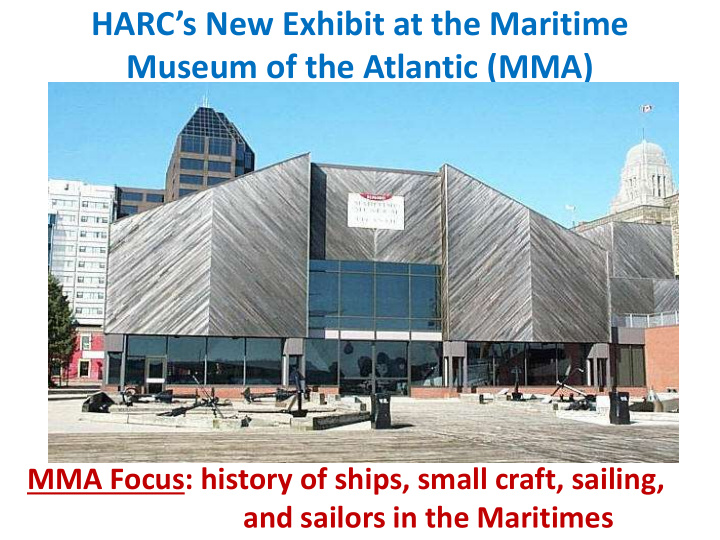



HARC’s New Exhibit at the Maritime Museum of the Atlantic (MMA) MMA Focus: history of ships, small craft, sailing, and sailors in the Maritimes
MMA’s main exhibition hall. HARC exhibit is on balcony facing hall.
HARC’s Permanent MMA Exhibit A large, new “Radio Office” with: • Part A. A working modern amateur radio station • -CW/SSB/Digital • HF + 2m • Part B. A working 1940s-1960s ship-board commercial/navy “radio office” -CW/AM/MCW -375 kc to 14.0 Mc Antennas: -80/40 m doublet -40-10 m multiband vertical -2 m vertical
The radio office’s story for MMA visitors Radio at Sea : ended age-old isolation of ships out of sight of land • Greatly aided navigation: – accurate time for longitudes – coastal beacons, RDF – WX forecasts • RX and TX distress calls • Coordination of ships at sea • Links with land “The SOS”
What Type of Ship’s Radio Office Should Be Displayed? Varied with: -time period, -ship type and size, -radio equipment used 1940s Marconi gear 1950s RCA Radiomarine gear
Heart of the HARC 1940-1960s ship radio office display: The Canadian Marconi CM-11 Ship Transmitter-Receiver Why the CM-11?? “ “ Remote” CM -11 on Haida - all Canadian design and manufacture - widely used 1942-1970s on ships + shore - uses available tubes and 115 VAC - I found two for free!! CM- 11 “vital statistics” - TX + RX: 375-515 kc, 1.5-14.0 Mc - RX ONLY: 78-550 kc, 14-30 Mc - 23 tubes, Xtal or VFO frequency control - AM, CW, MCW, RTTY - OUTPUT: 30W AM, 70 W MCW, 100W CW - WEIGHT: 479 lbs
1960s Radio #1 in RCN destroyer Haida : multiple listening posts with CSR-5s, and remote units to operate CM-11s in Radio #2
Sackville ’s radio office (1940s): locally operated CM-11 Tnx, Spud!
HMCS Swansea (1960) De Spud!
Quebec Radio Museum storage: CM-11A (left), CM-11 (right) 72 years old 73 years old
“As received” finish on the power supply
May 2015: two CM-11s arrive in Canard!
Goal: CM-11 Restoration - to good working order -to original appearance - with “period” accessories -with clear description of uses
The CM-11 Restoration: 1. Diasassemble (12 subunits) 2. Choose units to restore, cannibalize 3. Strip down, clean, re-paint 4. Obtain missing parts + accessories 5. Overhaul mechanically 6. Ohmmeter, tube + capacitor tester checks 7. Overhaul electrically 8. Assemble subunits (TX, RX, Tuner, + 3 P/S sections) 9. Apply power to subunits 10. Test/Troubleshoot and Align subunits 11. Apply power to complete CM-11 + Test
CSR-5A in original paint color
CM-11A Power Supply: 250 lbs!
The missing “Test Cable” and its snatch plugs
Room built for HARC radio displays
Amateur Station Ship’s Radio Office
1940s remote unit for CM-11 (for bridge, etc.)
Not quite finished.....
Tnx! • Musee Quebequois de la Radio – Jacques Hamel: VE2DJQ Gave us two CM-11s – Donald Courcy: VE1SS Lots of moving muscle for CM-11s HARC - Erik Hein VE1JEH Transported the brutes from Sorel, QC to Canard, NS! OTHER -Tom Brent: CM-11 aficianado – 575 kHz XTAL Filter -Jerry Proc: VE3FAB - HAIDA Radio Room restorer/info + manual source -Bill Perry: Mr. Amphenol connector -Wayne Blenkhorn: VE1BAB: key, decals, advice (former CM- 11 operator) -Corey Mullins: MMA tech who built the Radio Office!
Listening in a ship’s radio office with the CM - 11’s CSR -5 receiver
1940s -> 1960s Haida radio room VE3FAB
Radio office #1 on Haida . Remote units control CM-11s
Radio Office #2 on Haida You can tell these CM-11s are mainly run in remote: -no mill (typewriter) -no key
CM-11 and second CSR-5 RX often used together CSR-5 RX CM-11--> TX-RX
Combined Morse and radio training on the CSR-5 in WW2
Recommend
More recommend